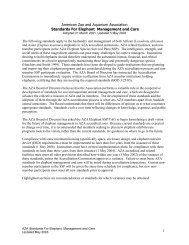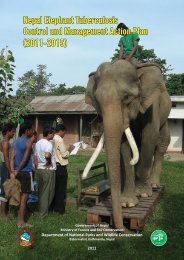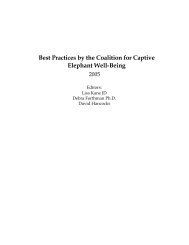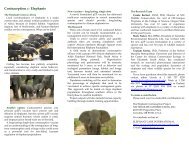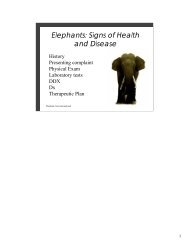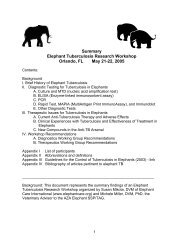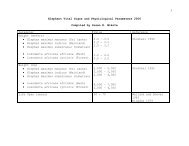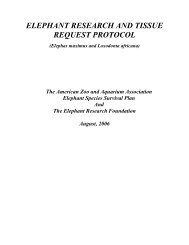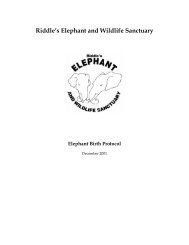Recommended Elephant Preshipment Guidelines - Elephant Care ...
Recommended Elephant Preshipment Guidelines - Elephant Care ...
Recommended Elephant Preshipment Guidelines - Elephant Care ...
You also want an ePaper? Increase the reach of your titles
YUMPU automatically turns print PDFs into web optimized ePapers that Google loves.
RECOMMENDED ELEPHANT PRESHIPMENT GUIDELINES<br />
American Zoo and Aquarium Association<br />
<strong>Elephant</strong> Species Survival Plan<br />
February 2003<br />
Routine health monitoring should be performed on all elephants on an annual basis (see “<strong>Guidelines</strong><br />
for Comprehensive <strong>Elephant</strong> Health Monitoring Program”). Animals should be trained to permit<br />
sampling and examination. Whenever possible, preshipment testing should be performed within 30-<br />
90 days of the anticipated shipping date (note: mycobacterial cultures require 60 days for final<br />
results). The following protocol advises that specific baseline laboratory tests be performed for the<br />
purpose of evaluating current health status. Additional tests are recommended to increase baseline<br />
information to determine their significance to elephant health. The final decision for specific<br />
procedures should be made in partnership between the shipping and receiving institutions. Any<br />
abnormal findings should be communicated to the receiving institution in a timely manner. For<br />
additional information, refer to the <strong>Elephant</strong> Husbandry Manual, AZA Standards for <strong>Elephant</strong><br />
Management and <strong>Care</strong>, and the AAZV Preventive Medicine Recommendations.<br />
Minimum Database:<br />
1. Signalment - age, sex, origin, studbook#, ISIS#; picture of individual (as viewed from the front and<br />
sides) should be included in the permanent record.<br />
2. Anamnesis - summary of information regarding previous health screens, medical problems,<br />
diagnostic test results, and treatment (complete “Individual Annual <strong>Elephant</strong> Medical Survey” form<br />
and send to SSP Veterinary Advisor – will be available in 2003). A hard copy and disc of the<br />
complete medical record should be sent to the receiving institution prior to shipment. In addition, the<br />
veterinarian should review the behavioral profile of the individual to be shipped.<br />
Specific areas to be included:<br />
a. foot/skin conditions<br />
b. dental/tusk conditions<br />
c. history of colic, diarrhea, GI parasitism (including fecal parasite screens and<br />
Salmonella cultures)<br />
d. serologic status, if known (EMC, elephant herpesvirus, Leptospirosis)<br />
e. vitamin E status, if known<br />
f. TB culture (dates and results)<br />
g. reproductive history<br />
b. musth history<br />
c. sedation/immobilization data<br />
3. Complete physical exam by a veterinarian familiar with elephant health problems. This should<br />
include a review of all systems.<br />
4. Body weight – actual or estimated using body measurements (1).<br />
5. Blood collection<br />
a. Complete blood count (CBC), serum chemistry panel.<br />
b. Serologic (ELISA) test for elephant herpesvirus – contact Drs. Laura Richman or Richard<br />
Montali (2). See Recommendations for EEHV Testing and Transport of <strong>Elephant</strong>s.<br />
c. Bank minimum of 10-20 ml serum (duplicate sample for SSP serum bank) – all banked<br />
samples should be labeled with species, studbook #, age, sex, and date collected. Use<br />
submission form for serum samples sent to SSP serum bank.<br />
6. Fecal analyses
a. Parasite screen - Fecal samples should be collected every 7 days for a total of 3<br />
weeks; direct, flotation, and sedimentation should be performed on every sample to<br />
detect intestinal parasitism.<br />
b. Enteric pathogen screen - Aerobic culture of feces for enteric pathogens should include<br />
special media for the detection of Salmonella spp. Since Salmonella organisms may be<br />
shed intermittently, at least 3-5 fecal cultures should be performed (may be done on<br />
consecutive days).<br />
c. Contact receiving institution with any abnormal results and treatments.<br />
7. TB culture - refer to the current USDA <strong>Guidelines</strong> for the Control of Tuberculosis in <strong>Elephant</strong>s<br />
(2). Protocol can be accessed on the USDA website<br />
www.aphis.usda.gov/ac/ElephTB<strong>Guidelines</strong>2003.html. At this time, annual trunk wash cultures are<br />
the only required test, however collection of other samples for research is strongly encouraged.<br />
a. Samples for cultures must be collected under the direct supervision of a licensed<br />
veterinarian.<br />
b. Three trunk wash samples should be collected on separate days, ideally within a 7 day<br />
period. Trunk swabs are no longer acceptable.<br />
c. All samples should be frozen immediately after collection and shipped frozen.<br />
d. Ship by overnight express to NVSL (or other laboratory facility offering comparable<br />
procedures). Request mycobacterial culture with speciation (use VS Form 10-4 submission<br />
form for NVSL).<br />
8. Vaccinations<br />
a. Tetanus toxoid *– current vaccination (within 12 months) with a commercial equine<br />
product is recommended. Follow label instructions for product use (usually 1 ml IM). Data<br />
are insufficient at this time to determine adequate protective vaccine doses and titers.<br />
b. Rabies vaccine* - current vaccination (within 12 months) with a commercial killed rabies<br />
product approved for horses should be considered if the animal resides or will be traveling to<br />
an endemic area. Follow label instructions for product use (usually 2 ml IM). Data are<br />
insufficient at this time to determine adequate protective vaccine doses and titers.<br />
* Both tetanus and rabies have been reported to occur in elephants (3, 4).<br />
Additional Preventive Health Recommendations:<br />
1. Serological screening for EMC (encephalomyocarditis virus), leptospirosis (multiple serovars),<br />
and WNV (West Nile Virus). Although these tests are not species-specific and have not been<br />
validated for elephants, they may detect cross-reactive antibodies in exposed animals. The<br />
presence of antibodies does not necessarily denote infection/disease. Encephalomyocarditis<br />
virus may cause clinical disease and death in elephants (5). Antibodies to leptospirosis have<br />
been detected in both Asian and African elephants (6, 7). At the time of this writing, EMC<br />
serologic testing was not available. Insufficient data is available at this time to determine the<br />
significant of WNV antibodies in elephants; it is important to include the history of exposure and<br />
vaccination to WNV when interpreting results.<br />
2. PCR test for elephant herpesvirus – contact Drs. Laura Richman or Richard Montali (8).<br />
3. Serum vitamin E levels – submit heparinized plasma to Dr. Ellen Dierenfeld.<br />
4. Reproductive tract examination – a complete reproductive examination should be conducted to<br />
include transrectal ultrasound, semen collection and analysis, cytology and microbial cultures of<br />
the lower urogenital tract (to be screened for bacteria, Chlamydia, protozoa, and Herpesvirus).<br />
Herpesvirus has been identified in biopsies of vaginal lymphoid patches in an African elephant<br />
(9). A high prevelance of uterine leiomyomas has been observed in captive Asian elephants and<br />
could be detected via transrectal ultrasound (10). Since both of these conditions have potentially<br />
significant effects on reproduction, a careful evaluation is warranted if the animal is being<br />
considered for breeding. All elephants (male and female) over the age of 5 years should have
oth ultrasound and hormonal assessments performed (testosterone in males; progestins/LH in<br />
females). See “<strong>Guidelines</strong> for Comprehensive <strong>Elephant</strong> Health Monitoring Program”.<br />
5. Urinalysis – fluid and sediment evaluation of clean voided sample; +/- microbial culture.<br />
6. Foot radiographs – baseline radiographs of all feet are strongly recommended (send copies of<br />
radiographs to receiving institution); see Gage for description of technique (11).<br />
7. Ancillary diagnostic tests for tuberculosis – ELISA, etc. recommended for data gathering; see<br />
<strong>Guidelines</strong> for the Control of Tuberculosis in <strong>Elephant</strong>s for current recommendations (2).<br />
8. Other vaccination regimens will depend on regional requirements and exposure risks<br />
(consider vaccination for equine encephalitis viruses, Clostridial diseases, Leptospirosis).<br />
Insufficient information is available at this time to provide a recommendation for West Nile<br />
Virus vaccination of elephants. Contact the SSP veterinary advisor for current information.<br />
2/20/03 mm
<strong>Elephant</strong> Serum Bank Submission Form<br />
American Zoo and Aquarium Association<br />
<strong>Elephant</strong> Species Survival Plan<br />
Institution/owner: _____________________________________________________<br />
Submitter:<br />
_____________________________________________________<br />
Address:<br />
_____________________________________________________<br />
_____________________________________________________<br />
Tel: _________________ Fax: _____________ Email: ______________________<br />
ANIMAL INFORMATION<br />
Asian [ ] African [ ] ISIS# ____________ Studbook # ______________<br />
Name ______________________ Age: _________ [ ] actual [ ] estimate<br />
Sex: [ ] male [ ] female<br />
SAMPLE COLLECTION INFORMATION<br />
Date of sample collection: ___________ Time of collection : __________<br />
Site of sample collection: [ ] ear vein [ ] leg vein [ ] other: ___________<br />
Health status of animal: [ ] normal [ ] abnormal<br />
Fasted: [ ] no [ ] yes – how long ______________<br />
Weight ________________ [ ] actual [ ] estimated<br />
Type of restraint: [ ] manual [ ] anesthetized/sedated [ ] behavioral control<br />
Temperament of animal: [ ] calm [ ] active [ ] excited<br />
Type of blood collection tube:<br />
[ ] no anticoagulant (red-top)<br />
[ ] EDTA (purple)<br />
[ ] heparin (green)<br />
[ ] other: ___________________<br />
Sample handling: [ ] separation of plasma/serum by centrifugation<br />
(check all that apply) [ ] stored as whole blood<br />
[ ] frozen plasma/serum<br />
[ ] other – describe _______________________<br />
TB EXPOSURE STATUS<br />
[ ] Known infected animal<br />
[ ] Known exposure to culture positive source within the past 12 months<br />
[ ] Known exposure to a culture positive source within the past 1-5 years<br />
[ ] No know exposure to a culture positive source in the last 5 years<br />
TREATMENT INFORMATION<br />
Is elephant currently receiving any medication or under treatment? [ ] yes [ ] no<br />
If yes, please list drugs and doses: ____________________________________<br />
_______________________________________________________________<br />
_______________________________________________________________<br />
Time between blood collection and last treatment: ______________________<br />
Ship samples overnight frozen with shipping box marked “PLACE IN FREEZER UPON ARRIVAL”<br />
Send completed form with samples to:<br />
Dr. Michele Miller<br />
Disney’s Animal Kingdom-Dept. of Vet. Services<br />
1300 N. Savannah Circle West<br />
Bay Lake, FL 32830<br />
(407) 939-7316; email: Michele.Miller@disney.com




